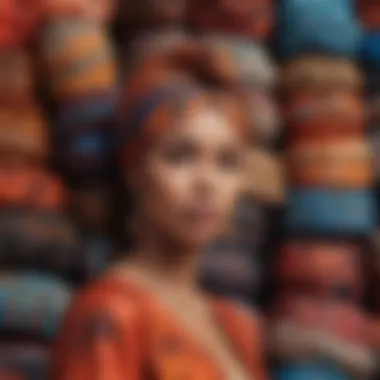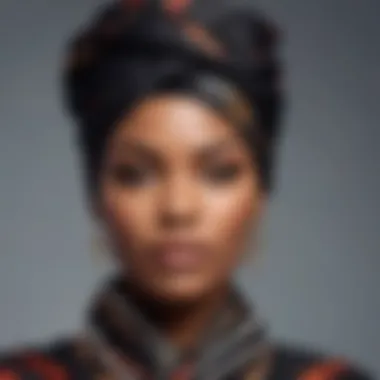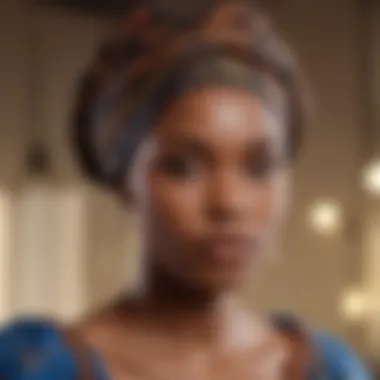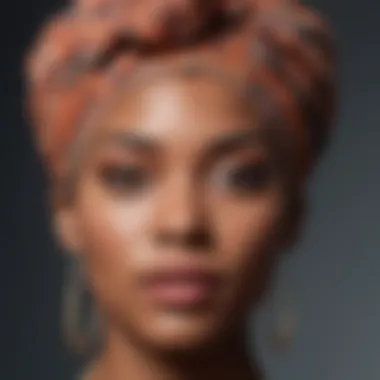The Cultural Impact of Black-Owned Headwraps in Fashion


Intro
Headwraps have long transcended their primary function as mere fashion accessories. They hold deep cultural significance, especially within the black community. In recent years, there has been a resurgence in the popularity of black-owned headwraps, reflecting a broader trend of statement-making fashion that intertwines personal identity with style. This article aims to thoroughly examine the richness of this topic, showcasing how headwraps are not only vibrant additions to contemporary fashion but also powerful symbols of heritage and empowerment.
Key Trends
Overview of Current Fashion Trends
The fashion landscape is dynamic, with trends emerging and evolving constantly. In 2023, black-owned brands have led many of these trends, embracing bold colors, diverse patterns, and handmade craftsmanship. Headwraps are now celebrated for their versatility, allowing wearers to express personal style while connecting with cultural heritage.
Key elements of these trends include:
- Diverse Styles: Ranging from intricate knotting techniques to oversized fabrics, there is a variety of choices available.
- Cultural Representation: Many brands are incorporating traditional designs, offering authenticity and storytelling.
- Inclusivity: Headwraps are actively celebrated across different cultures, showcasing their universal appeal.
Popular Beauty Trends
In addition to headwraps, beauty trends have aligned closely with this cultural revival. More individuals are embracing natural textures and styles, promoting the idea that beauty is diverse. This shift is observed in the focus on skincare and hairstyles that enhance natural beauty rather than masking it. Black-owned brands are often at the forefront, guiding these movements with a deep understanding of different skin tones and hair types.
Beauty Tips and Tutorials
Skincare Routines for Different Skin Types
Understanding skincare is essential. Black-owned brands offer products that cater to various skin types, promoting healthy skin maintenance. Key tips include:
- Cleansing: Use gentle, hydrating cleansers to remove impurities without stripping oils.
- Moisturizing: Opt for products with natural ingredients like shea butter or jojoba oil.
- Sunscreen: Essential for all skin types, it protects against damage and hyperpigmentation.
Step-by-Step Makeup Tutorials
For those who incorporate headwraps into their beauty routines, makeup can enhance the overall look. Simple tutorials can guide you through:
- Foundation Application: Choose shades that complement your skin tone.
- Eye Makeup: Accent eyes with vibrant shades that match or contrast the headwrap.
- Lip Color: Bold lip colors can add a focal point, enhancing the overall appearance.
Sustainable Practices
Understanding Sustainable Fashion
The conversation around sustainable practices in fashion is gaining traction, highlighting ethical consumption patterns. Black-owned headwrap brands often prioritize sustainability, using eco-friendly materials and fair labor practices. Understanding this approach helps consumers make informed decisions.
Tips for Sustainable Beauty
To incorporate sustainability in beauty routines:
- Choose Brands Wisely: Support those committed to eco-friendly practices.
- Limit Waste: Opt for refillable or reusable products.
- Educate Yourself: Stay informed about brands' commitments to sustainability.
Supporting black-owned headwrap brands contributes not only to individual style but also to cultural and economic empowerment.
Headwraps symbolize more than just fashion; they embody a rich heritage and the stories of those who wear them. As the popularity of these accessories grows, it calls for mindful appreciation and engagement with the narratives behind them.
Preamble to Headwraps


The realm of fashion continuously evolves, reflecting societal changes and cultural heritage. Headwraps, once simple textiles, have transformed into powerful symbols of identity and cultural expression in contemporary fashion. This segment aims to establish a foundation for comprehending headwraps' significance.
Headwraps are more than just accessories. They play a crucial role in representing history, cultural significance, and individual style. Understanding headwraps involves examining the intricate threads that weave together identity, empowerment, and the reclaiming of cultural narratives. For many, wearing a headwrap is an act of pride, a statement of heritage that transcends mere aesthetics.
The upcoming sections will delve into the definition and origins of headwraps, along with the rich cultural significance they hold. These discussions are essential for a nuanced understanding of why these textiles have re-emerged in popular fashion. They serve various purposes beyond everyday wear, influencing fashion choices and challenging societal norms.
This analysis will illustrate not only the beauty of headwraps but also their deeper implications in modern society. Fashion enthusiasts, culturally conscious individuals, and those curious about identity will find this exploration valuable.
Definition and Origins of Headwraps
Headwraps, commonly known as turbans or do-rags, vary in design, materials, and significance. The basic definition describes them as pieces of fabric, often worn on the head. Their origins trace back thousands of years across various cultures, particularly in African societies where they have held significant cultural value.
Historically, headwraps have signified various social standings and roles. Within African communities, specific styles communicated marital status or rank. The materials used ranged from simple cotton to richly decorated textiles, indicating wealth and craftsmanship. The practice of wrapping one’s hair is not monolithic; it varies across regions and cultures, each imbuing its own symbolism.
The peace and tradition associated with headwraps point to their enduring nature. As they drifted into different cultural landscapes, including Western society, their meanings adapted. However, many core principles, such as self-expression and identity, have consistently remained.
Cultural Significance of Headwraps
Understanding the cultural significance of headwraps requires an acknowledgment of their historical context. For many Black women, headwraps are not just protective styles but vital expressions of their heritage. They can symbolize resistance against racial stereotypes and reclamation of cultural narratives. Wearing a headwrap often embodies a connection to ancestral roots and a celebration of cultural pride.
Headwraps have made significant appearances in various media and pop culture, interweaving fashion with activism. They challenge traditional beauty standards, highlighting diversity and individuality. Symbols of liberation take form in vibrant patterns and colors, representing joy in identity. The popularity of headwraps has led many to connect with their history and share it with wider audiences.
"Headwraps serve as a form of armor, a protective shield against societal misconceptions and biases."
This embrace of headwraps in contemporary culture is a testimony to their resilience and adaptability. They now appear in diverse fashion scenes, from runway shows to everyday wear, illustrating their capacity to blend tradition with modernity. Understanding their cultural significance fosters a deeper appreciation of the narratives behind them, encouraging thoughtful consumption and recognition of Black-owned businesses.
Historical Context
Understanding the historical context of headwraps is essential for appreciating their significance in contemporary fashion. Headwraps are not merely accessories; they are embedded deeply in the narratives of African cultures, shaped by historical events and social dynamics. This section outlines the multifaceted history of headwraps, focusing on key elements that contribute to their current status as symbols of identity and empowerment.
Headwraps in African Traditions
In many African cultures, headwraps have been worn for centuries. They often signify various social statuses and cultural identities. For example, in countries such as Nigeria, Ghana, and Senegal, the way a headwrap is styled can indicate a woman's marital status or social standing. The fabric, color, and even the tying technique carry meaning and signal belonging to cultural groups. These traditions emphasize the importance of headwraps as a medium through which women express their heritage. It is also a form of artistry, where each wrap showcases intricate designs, patterns, and textiles unique to different regions.
Impact of Colonialism
Colonialism had a profound impact on the perception and usage of headwraps in Africa and among the African diaspora. As colonizers imposed their cultural norms, traditional attire, including headwraps, was often vilified or considered primitive. Many African women faced ridicule for wearing headwraps in public or were forced to abandon these practices for European clothing styles. This led to a complex relationship with headwraps, where they became symbols of both oppression and resistance. Even in diasporic communities, headwraps began to embody a reconnection to roots and a means of expressing Black pride in the face of prevailing narratives that attempted to erase African culture.
Evolving Styles Over Generations
Over generations, the styles and significance of headwraps have evolved considerably. The modern era has seen a resurgence in the popularity of headwraps, particularly among Black women. This resurgence is often seen as a form of reclaiming cultural identity and self-empowerment. Contemporary designers incorporate modern fashions with traditional techniques, crafting vibrant and creative headwrap styles that appeal to new audiences. Moreover, social media platforms have played a substantial role in this evolution, allowing individuals to share styling techniques and narratives. Notably, what was once an everyday accessory has now seen a transformation into a fashion statement, blending historical resonance with current trends.
"Headwraps carry within them the stories of struggle, resilience, and beauty. They connect generations and embody a journey back to cultural roots."
Black-Owned Headwrap Brands
The emergence of black-owned headwrap brands marks a pivotal moment in contemporary fashion. These brands are not merely selling accessories; they express a rich cultural heritage and a commitment to social responsibility. The significance of supporting black-owned businesses in this realm goes beyond economics. It fosters a sense of community, empowerment, and awareness of cultural narratives that shape the identity of many women today.
Choosing to purchase from black-owned headwrap brands supports not just the designers but also their communities. This creates a ripple effect, as these businesses often invest back into local initiatives and cultural education. By highlighting these brands, the article seeks to illuminate their profound impact and the narratives that they encapsulate.
Emerging Designers in the Market


New designers are continuously entering the market, bringing fresh perspectives and creativity to the world of headwraps. Many of these emerging designers are motivated by personal stories or cultural heritage, which they express through their unique designs. For instance, brands like Dipped in Melanin and The Wrap Life are showcasing vibrant patterns and textiles that resonate with contemporary influences while drawing from traditional roots. This revitalization of headwrap design is essential, as it allows for new interpretations and styles that appeal to a broader audience.
The emergence of such designers is vital for diversifying the fashion landscape. They often utilize sustainable practices and materials, which align with the growing consumer demand for ethical fashion choices. Young designers face numerous hurdles, such as limited access to capital and resources, yet their resilience is evident in the creativity they bring.
Notable Established Brands
Established brands play a critical role in empowering the narrative around headwraps. Companies like Nubian Hueman and Ankara Queen have built their identities on promoting authenticity and quality craftsmanship. These brands not only produce stylish headwraps but also emphasize the stories behind their creation. They often source materials directly from artisans in Africa, ensuring that the cultural heritage is honored and financially supported.
These brands also serve as mentors to emerging designers. They often share valuable insights on managing a sustainable business and navigating the complexities of the fashion industry. Established brands reinforce the idea that headwraps are more than just an accessory; they are part of a larger dialogue about black culture, identity, and empowerment.
The Role of Social Media in Brand Growth
Social media has revolutionized the fashion industry, particularly for black-owned headwrap brands. Platforms like Instagram and TikTok have become essential tools for marketing and fostering community engagement. Emerging businesses can showcase their collections directly to consumers, reducing reliance on traditional retail channels. The visual nature of these platforms allows designers to highlight their unique styles effectively.
Additionally, social media provides a space for conversation about representation, self-expression, and cultural pride. Hashtags like #headwraps and #blackownedbusiness amplify visibility. This empowers consumers to make informed choices about where they shop. Influencers and creators use their platforms to not only promote specific brands but also educate their audience on the significance of headwraps in black culture.
Social media serves as a modern platform for empowerment, allowing black-owned brands to thrive and shape their own narratives.
As these brands gain recognition, they create pathways for growth and collaboration, reshaping the landscape of contemporary fashion.
In summary, black-owned headwrap brands are integral to understanding the cultural significance and economic implications of fashion today. They cultivate a sense of identity, community, and empowerment that resonates with women across various age groups.
Styling Headwraps
Styling headwraps is more than just a fashion choice; it serves as a means of self-expression and a connection to cultural heritage. Headwraps can transform an outfit, adding flair and character. They also carry historical significance that many wearers honor. Understanding the importance of headwrap styling is crucial for anyone wishing to incorporate these accessories into their wardrobe effectively.
Different Ways to Wear a Headwrap
Wearing a headwrap can be versatile. Each style can convey different messages, from formality to casualness. Here are some popular methods:
- Classic Wrap: This is a traditional method where the headwrap is secured at the base of the neck, covering the entire head. This style is sleek and can be paired with elegant attire.
- Turban Style: This involves folding the fabric into a unique twist at the front. It offers sophistication and is excellent for formal events.
- Buntal Style: This style is free-flowing with the fabric draping down the back. It adds an element of grace and is often seen at cultural celebrations.
- Casual Knot: For a relaxed look, this involves loosely knotting the wrap at the front of the head. This casual style can complement daily casual wear.
Each style can reflect personal identity and resonate with the wearer’s background. By experimenting with various looks, individuals can showcase their creativity.
Pairing with Various Outfits
Knowing how to pair headwraps with different outfits enhances both the style and its impact. It is essential to consider the outfit's color, fabric, and overall vibe. Here are some pairing suggestions:
- Denim and Casual Attire: A colorful headwrap can brighten a simple jeans and T-shirt look. Pairing extends the overall aesthetic to a contemporary feel.
- Formal Wear: For upscale occasions, a solid color or metallic headwrap can add elegance. It is often wise to coordinate with the dress's color scheme for a coherent look.
- Cultural Clothing: Wearing a headwrap that mirrors cultural attire can create a powerful statement. Matching patterns and styles can show pride and respect for heritage.
- Athletic Wear: A headwrap can be a stylish and functional accessory. It can add uniqueness to gym outfits while keeping hair in place during workouts.
By making informed choices about how to pair headwraps, wearers can amplify their fashion statements while also showcasing their unique identities.
Caring for and Maintaining Headwraps
Proper care for headwraps ensures their longevity and sustained aesthetic appeal. Various materials used in headwraps require different maintenance approaches. Here are general tips for caring for headwraps:
- Washing: Always check care instructions. Cotton and cotton blends are usually machine washable, while silk may need gentle hand washing.
- Drying: Air drying is recommended to prevent shrinkage. Avoid direct sunlight as it can fade colors over time.
- Storing: Store headwraps flat or rolled to avoid creases. A dedicated drawer or box can protect them from damage.
- Ironing: If necessary, use a low heat setting on fabrics like cotton. For silk, a cooler setting or steamer is advisable.
By implementing these care strategies, wearers can maintain the integrity and beauty of their headwraps. This approach not only respects the investment but also honors the cultural significance behind these beautiful accessories.
"Headwraps are not just a fashion statement; they are a profound connection to culture, identity, and empowerment."


Through mastering the art of styling headwraps, wearers can embrace their personal narratives while celebrating their cultural heritage.
Economic Impact of Supporting Black-Owned Brands
Supporting black-owned headwrap brands holds significant economic importance in today's fashion landscape. The impact of these brands extends beyond individual profit; it strengthens the entire community. Providing support to these businesses fosters economic growth and creates job opportunities. Additionally, it enhances the visibility of black culture in mainstream fashion.
Consumer Responsibility and Choices
Consumers today increasingly recognize the power of their purchasing decisions. Buying from black-owned brands promotes economic empowerment within black communities. Every purchase is a statement of solidarity and support, reflecting awareness of the systemic inequality that exists in business sectors. Choosing to support these brands contributes to a more equitable market environment. Many consumers are now considering the origin of their purchases, seeking brands that align with their values. This shift in consumer behavior encourages aspiring entrepreneurs and established business owners alike to cultivate innovative designs that resonate with a diverse audience.
Challenges Faced by Black Entrepreneurs
Despite the growing consumer interest, black entrepreneurs in the headwrap market face significant challenges. Access to funding is often limited. Many banks and investors may overlook black-owned businesses due to biases or misconceptions about their viability. Furthermore, the lack of mentorship and professional networks can hinder their growth. Compounded by these factors, navigating the competitive landscape of fashion poses additional hurdles. These challenges underscore the importance of community support for black-owned brands.
Impact on Local Communities
By supporting black-owned headwrap brands, consumers indirectly improve their local communities. Economic investment leads to job creation, which develops local talent and skillsets. Furthermore, thriving businesses contribute to local economies through taxes and community initiatives. Stronger businesses can invest in community programs, schools, and various social initiatives that aim to uplift marginalized populations.
Investing in black-owned brands is not just an act of consumption; it's a commitment to the growth, sustainability, and empowerment of entire communities.
Headwraps as Symbols of Empowerment
In contemporary society, headwraps have evolved beyond mere fashion accessories. They now embody deeper meanings related to identity, culture, and empowerment. Many women choose to wear headwraps not just for style, but as a statement—proclaiming their heritage and reclaiming their narrative. This section explores how headwraps serve as symbols of empowerment for women today.
Reclaiming Identity Through Fashion
Headwraps play a crucial role in the journey of self-acceptance and cultural reclamation. For many black women, wearing a headwrap is an act of affirming their identity. It is a way to connect with their roots and celebrate their cultural heritage. The colors and patterns chosen often reflect personal stories or ancestral ties, making each headwrap unique.
This practice fosters a sense of belonging and pride. Women who don them often find strength in these simple yet profound accessories, which allow them to express themselves. Combining traditional designs with modern styles emphasizes the beauty of versatility in black culture. Ultimately, wearing headwraps can be seen as a celebration of one's identity in a world where traditional norms often overshadow individuality.
Representation in Media and Pop Culture
Media representation shapes societal perceptions, and the headwrap is no exception. In recent years, there has been a noticeable shift towards more positive representation of headwraps in various media platforms. Celebrities and influential figures, like Lupita Nyong'o and Solange Knowles, have embraced this accessory, using their platforms to highlight its significance.
These representations challenge stereotypes and mainstream beauty standards. They elevate headwraps from mere fashion statements to symbols of resilience and empowerment. Documentaries, social media campaigns, and fashion shows that emphasize these themes contribute to an ongoing dialogue about cultural appreciation versus cultural appropriation. Audiences are increasingly aware of the significance of headwraps, leading to a broader acceptance and understanding of black culture in fashion.
Community Initiatives and Movements
The popularity of headwraps has spurred numerous community initiatives aimed at promoting cultural awareness and solidarity. Organizations focused on black empowerment often host workshops and events where women can learn about the history and styling of headwraps. This is not only educational but also serves as a platform for women to share their experiences and connect with one another.
Through community gatherings, headwraps become vehicles for dialogue about empowerment and self-expression. These initiatives help counter negative stereotypes while fostering a strong sense of community. Women use this time not just to style their headwraps, but to celebrate their identity collectively, reinforcing bonds within their communities.
"Wearing a headwrap is more than just a style choice; it's a powerful statement of who we are and where we come from."
As interest in these traditions grows, so does the importance of supporting local black-owned businesses that produce headwraps. This creates a cycle of empowerment by uplifting the community economically while fostering cultural pride. Thus, headwraps serve as catalysts for fierce and meaningful discussions, with implications reaching far beyond personal fashion.
The End
The conclusion of this article serves to encapsulate the rich discussion surrounding black-owned headwraps in contemporary fashion. It highlights the multifaceted importance of these accessories, emphasizing their role in cultural identity, empowerment, and economic impact. By synthesizing historical context with modern-day relevance, the conclusion reinforces the notion that headwraps are not merely fashion statements but rather significant markers of heritage and individual expression.
Reflections on the Journey of Headwraps
The journey of headwraps is steeped in history. Originally a symbol of cultural pride, headwraps have adapted through different eras and societal shifts. From their roots in African traditions to their resistance against colonial influences, headwraps embody a narrative of resilience.
Contemporary designers have successfully merged traditional aesthetics with modern sensibilities, making headwraps a staple in various wardrobes. Many women now use these accessories to reconnect with their heritage or to assert their identity in everyday life. This evolution reflects broader societal changes where diversity in fashion is increasingly celebrated.
Looking Ahead: Sustainable Practices
As the fashion landscape shifts, the emphasis on sustainability becomes crucial. Black-owned headwrap brands increasingly prioritize eco-friendly materials and ethical production methods. This is not just a trend but a necessary transition in addressing the broader impact of the fashion industry on the environment.
Adopting sustainable practices benefits both the planet and the communities involved in their creation. Supporting these brands not only promotes cultural preservation but also encourages responsible consumerism.



